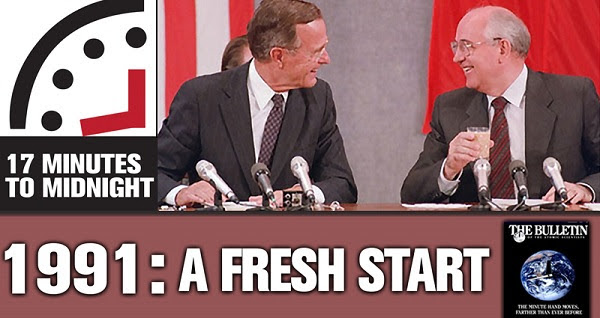Twenty-five years ago this past Sunday, the world gave a heavy sigh of relief. On July 31st, 1991, Presidents Mikhail Gorbachev and George H.W. Bush signed the first Strategic Arms Reduction Treaty, or more commonly, START I. The treaty limited the nuclear arsenals on either side of the Iron Curtain to 6,000 warheads and 1,600 Strategic Nuclear Delivery Vehicles (SNDVs) by 1999.
The Bulletin understood the landmark importance of START. As a response, the Board moved the Doomsday Clock to 17 minutes to midnight, the furthest it has ever stood. The Bulletin declared, “[t]he illusion that tens of thousands of nuclear weapons are a guarantor of national security has been stripped away.”
The dissolution of the Soviet Union a few months later was both an unforeseen challenge to START and a testament to the diplomatic consensus that underlay the agreement. Besides Russia, three former Soviet satellite nations–Belarus, Ukraine, and Kazakhstan–had nuclear weapons in their territory. It took three years, but with these loose ends tied up in the Lisbon Protocol, START came into effect on December 5, 1994.
Progress toward disarmament faltered. Ensuing treaties, such as START II, START III, and SORT, either failed or were criticized for being too ineffectual. The Doomsday Clock crept forward from 17 minutes to 5. Two years before its sunset in 2009,Bulletin columnist Pavel Podvig worried what a world after START would look like.

Unfortunately, the years after New START saw a return of Cold War-style military exercises and weapon productions. Russia’s arsenal has fallen to 4,500 strategic long range weapons, but as many as 2,800 warheads await dismantlement. On the US side, the nuclear arsenal reduction has plateaued around 4,700 with no immediate signs of continued disarmament. Meanwhile, the Obama administration is proposing to spend $1 trillionin the next 30 years on modernizing the entire nuclear arsenal.
As relations between the United States and Russia become increasingly strained and diplomacy seems worryingly improbable, it’s important to reflect on our most successful treaties to recall that international cooperation is the crucial way to a world without nuclear weapons.
For more reading, see the special May-June 2016 issue of the Bulletin’s digital journal,US-Russia relations: Cold War 2.0?










